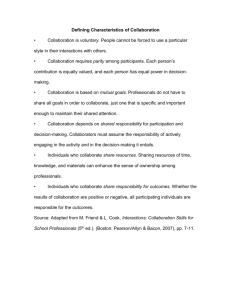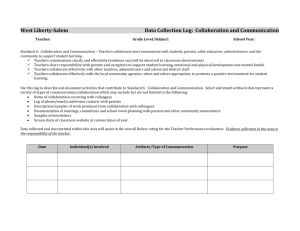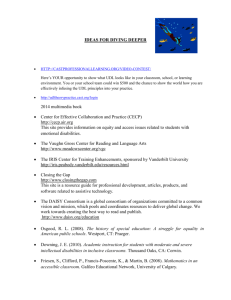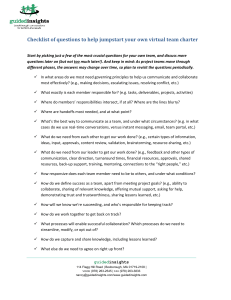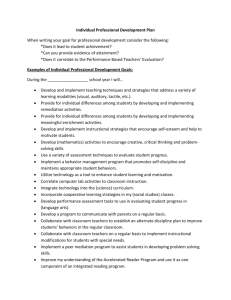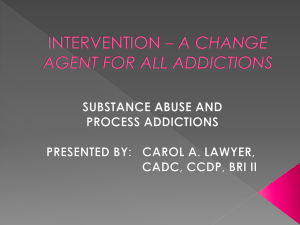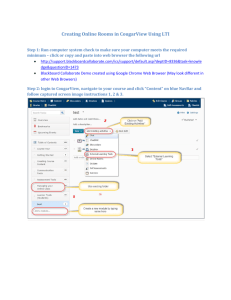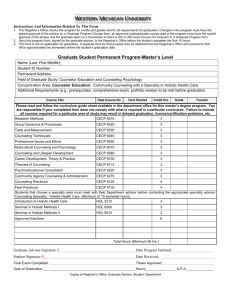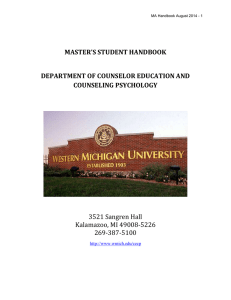Dr. Osher's presentation
advertisement
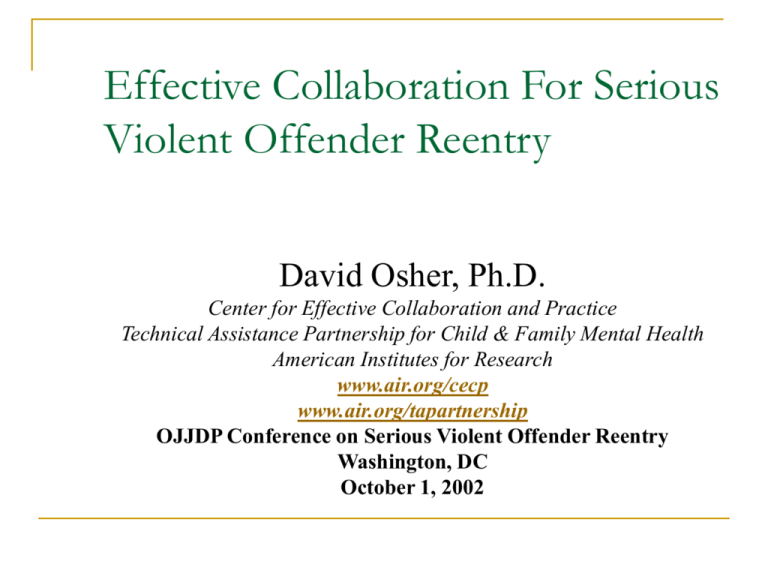
Effective Collaboration For Serious Violent Offender Reentry David Osher, Ph.D. Center for Effective Collaboration and Practice Technical Assistance Partnership for Child & Family Mental Health American Institutes for Research www.air.org/cecp www.air.org/tapartnership OJJDP Conference on Serious Violent Offender Reentry Washington, DC October 1, 2002 Why Collaborate? Youth Have Multiple Needs Mental health Physical Health Substance Abuse Prevention & Treatment Education Employment Housing Recreation Spiritual Family Why Collaborate? Stakeholders have Multiple Concerns About Short and Long-Term Educational, Vocational, Civic, and Safety Outcomes Families Schools Taxpayers Why Collaborate? Eliminate Fragmentation Eliminate Duplication Eliminate Distrust Use Scarce Resources Wisely Address Multiple Risk Factors Across Multiple Domains Improve the Effectiveness of Interventions Build Capacity—No Agency Can Do It Alone Enhance Staff & Community Safety Collaboration is Not a Good in Itself Can Collaborate to Do Bad Things (or because the “Boss told you to”) Can Collaborate to Do Good Things, but Do them Badly Cultural Barriers to Collaboration Knowledge Professional Socialization Language Missions, Values, Beliefs, Rituals Communities of Knowledge and Communities of Practice Constituencies and their expectations Structural Barriers to Collaboration Mandates & Accountability Funding Streams Organization of Resources Jobs Money Time The burden of routine What is on the desk when one gets back from a planning meeting Other Barriers to Collaboration Self-interest Turf Management of Change Agency Driven approaches to planning and evaluation Who is Collaborating (Different Dynamics) Agency Collaboration Inter Agency Collaboration Family Agency Collaboration Family Interagency Collaboration Agency Community Collaboration Faith Based and Community Collaboration Inter Agency Community Collaboration Interagency Family Community Collaboration We can Distinguish Between Two Approaches to Service Delivery PROVIDER DRIVEN CHILD & FAMILY DRIVEN SOURCE OF SOLUTIONS RELATIONSHIP ORIENTATION professional ASSESSMENT PLANNING strengths based individualized for each child and family limited by agency’s menu comprehensive and and professional provided when and where convenience the child and family require low high based on symptoms based on quality of life and desires of child and family PROGRAM SERVICE AVAILABILITY EXPECTIATIONS OUTCOMES dependent client isolating and “fixing” a problem viewed as residing in the child or family deficit oriented resource based family and their support team partner/collaborator ecological approach enabling the child and family to do better Provider-driven Systems •Professionals and agencies are viewed as the key force in solving problems. •Providers “fix” their “clients” who are compliant and passive. Family members often share this orientation because: •they are socialized to it as a sign of respect; •they are fulfilling the expectations of the system in order to insure they get services; •they have been blamed, labeled dysfunctional, judged inadequate or otherwise deemed unfit to make decisions. Family-driven Systems • Responsibility for decision making is held collectively and equally by all members of the team. The Family is: •deemed to have expert knowledge regarding their child; and •expected to contribute to defining and resolving the issues. Family-driven Practice in ACTION Example Back End: Rhode Island Parent Support Network Led Transition Planning at the RITS Characteristics of Effective Community-Wide Collaborations Shared Ownership and Accountability Consumer-Driven Consumer-centered Goals and Orientation Multi-disciplinary across multiple domains Strategic & Data Driven Individual & Collective Accountability Culturally Competent Problem-Solving Approach Clear, Consistent, & Simple Interventions & Expectations Characteristics of Effective Collaborations Sustained Supportive Infrastructure Institutionalized through Policy Leadership Management Protocols & Procedures, Practices Monitoring CQI Evaluation Impact of Collaboration Agency staff have come to know their counterparts in other agencies and are friendlier with one another; allowing them to work with one another in a more respectful way. Agencies work together to change or adapt to a situation rather than place blame. Shifting the focus of service delivery from the individual service provider to the system as a whole. Impact of Collaboration Less service fragmentation. Better response to specialized through more appropriate service options. Enhanced access to services Improved ability to consider the needs of the “whole child and the whole family” within the context of their community. Collaborative Outcomes: The Bottom Line KEEP IT SIMPLE KEEP IT REAL KEEP THE FOCUS ON THE CHILD THE FAMILY COMMUNITY CAPACITY & SAFETY LINK IT TO A THEORY OF CHANGE Towards Effective Collaboration Talking the Talk Walking the Talk Walking the Walk Collaboration as a Developmental Process Stage I: Individual Action Stage II: One-on-One Stage III: New Service Development Stage IV: Professional Collaboration Stage V: True Collaboration Promising Practices in Children’s Mental Health: Volume VI Resources www.air.org/cecp Video: Making Collaboration Work for Children, Youth, Families, Schools, & Communities (CEC) Video: Promising Practices for Safe and Effective Schools (OJJDP) Promising Practices in Children’s Mental Health (CECP, 1999, 2000, 2001) 13 Volumes Improving Prevention, Providing More Efficient Services, and Reducing Recidivism For Youth With Disabilities (CECP/EDJJ)
